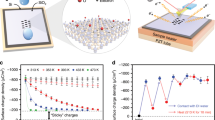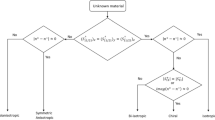Abstract
CERTAIN dielectric materials, if solidified from the molten state in a strong unidirectional electric field, are known to remain in a polarized condition for considerable periods of time and, under certain conditions, surface charges as high as 5 E.S.U./cm.2 are retained for several years1. The materials generally used for the preparation of these so-called ‘electrets’ are mixtures of carnauba wax and colophony, or carnauba wax, colophony and a small proportion of beeswax.
This is a preview of subscription content, access via your institution
Access options
Subscribe to this journal
Receive 51 print issues and online access
$199.00 per year
only $3.90 per issue
Buy this article
- Purchase on Springer Link
- Instant access to full article PDF
Prices may be subject to local taxes which are calculated during checkout
Similar content being viewed by others
References
Eguchi, Phil. Mag., 49, 178 (1925).
Gemant, Phil. Mag., 20, 929 (1935).
Jaeger, Ann. Phys., 21, 481 (1934).
Thiessen, Winkel and Herman, Phys. Z., 37, 511 (1936).
Author information
Authors and Affiliations
Rights and permissions
About this article
Cite this article
PARTINGTON, J., PLANER, G. & BOSWELL, I. Surface Charge of ‘Electrets’. Nature 158, 835–836 (1946). https://doi.org/10.1038/158835b0
Issue Date:
DOI: https://doi.org/10.1038/158835b0
This article is cited by
-
Orientation of cetyl alcohol in a high D. C. field in relation to Gross's theory of the electret
Die Naturwissenschaften (1962)
Comments
By submitting a comment you agree to abide by our Terms and Community Guidelines. If you find something abusive or that does not comply with our terms or guidelines please flag it as inappropriate.



